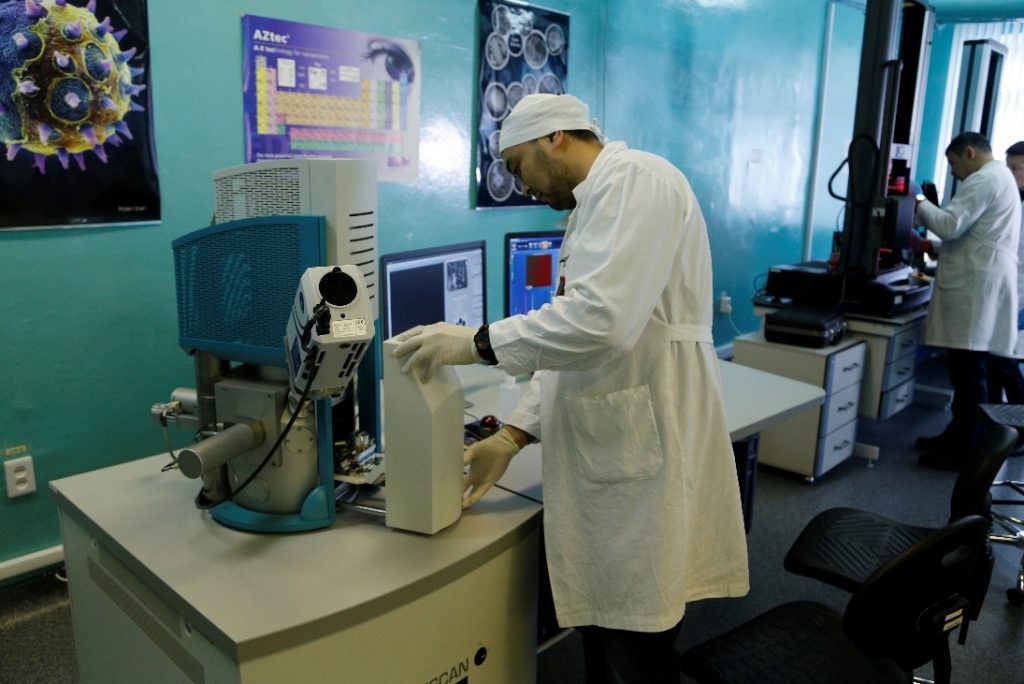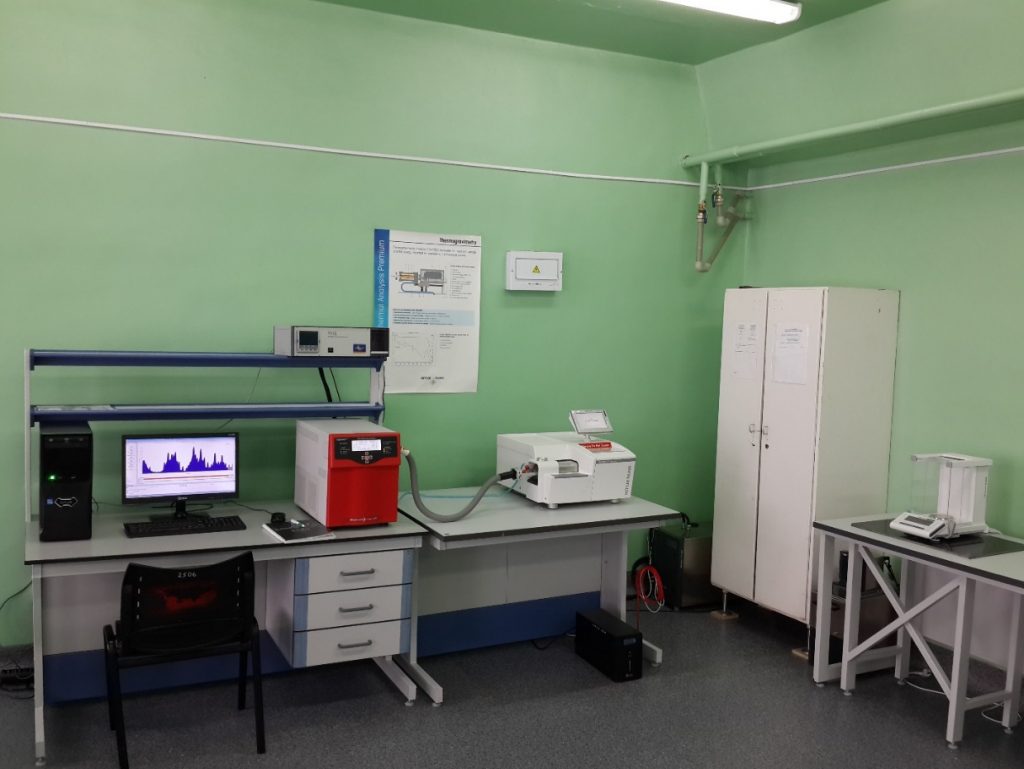GAMMA-SPECTROMETRIC COMPLEX
The complex is designed to measure the activity of radionuclides; measuring the total activity of the samples; measuring the spectra of ionizing radiation; determination of the radionuclide composition of the samples, activity of activation indicators and activity of fission products in the fuel elements of the WCTC and other fuel compositions.
Gamma-spectrometric measurements allow non-destructive testing of radioactive materials directly at their locations.
Sampling method for determining the relative release of fission products. Investigations of the coolant activity at the IVG.1M reactor start-ups, in order to determine content of fission products in the coolant using a semiconductor gamma detector, are conducted in accordance with the Physical Studies on the Cladding Failure Detection System of Fuel Elements of the IVG.1M Reactor Program
Instrumental neutron activation analysis (INAA). When implementing the instrumental version of the multielement neutron activation analysis for selective measurement of the studied radionuclide activity, not their radiochemical separation is used, but only hardware and special programs for processing the registered gamma spectra.
For implementation of the INAA at the NNC’s reactors, the input data are: sample irradiation modes, exposure modes and measurement time .
The operating gamma-spectrometric complex includes the following equipment:
– Germanium semiconductor detectors CANBERRA;
– Scintillation detectors CANBERRA 802-3;
– Gamma spectrometers (spectrum analyzers): InSpector, InSpector-2000, DSA-LX;
– Analitical balances: ВЛР-200, OHAUS pioneer PA64C;
– Dewar vessels (with volume from 17 to 30 l );
– Low background protection, collimator.
- Gamma spectrometric analysis
- Canberra Portable HPGe Coaxial Gamma Detector
Main research area:
– obtaining experimental data on the activation of analyte elements in samples of nuclear technology materials, studying the conditions of exposure and measuring samples;
– conducting k0-INAA for irradiation together with nuclear technology materials of reference materials with certified values of the proportion of analytical elements in the samples (up to 30 elements determined using INAA);
– determination of trace impurities in the composition of samples by the relative method (method of standards);
– determination of energy release (specific number of fissions) in energy release monitors, fuel elements and specific number of reactions by activation indicators (AI); determination of the relative content of 235U in fuel detectors;
– determination of the relative distribution of the gamma radiation intensity throughout the height of the experimental device (ED) in order to predict the possible distribution of the fuel melt in the ED cavity;
– coolant activity assessment, determination of the fission product content (in the IVG.1M reactor coolant).
The complex is used in the IVG.1M reactor system, which ensures the technically correct and safe reactor operation, in particular, in the fuel cladding failure detection system (CFDS) – during start-up shifts, the content of fission products in the IVG reactor coolant is determined by the sampling method. In addition, using the complex, identification of radionuclides in the composition of IRS and TNR arriving for long-term storage is carried out.
MATERIAL TESTING COMPLEX
UTFI-2 Installation
The UTFI-2 installation is designed to study the aspects of thermophysical specifications of a model oxide nuclear fuel – thermal diffusivity, heating capacity, thermal conductivity. UTFI-2 installation enables studying thermophysical properties of materials with thermal conductivity within the range from 2 to 20 W×m-1×K-1, within the temperature range of 20 – 800 0С. Thermophysical properties is determined by “flush” method. The studies can either be conducted in vacuum and inert gas medium.

Technical specifications:
Power supply…………………………………………… alternating current (220 V ± 2 %, 50 Hz);
Power consumption………………………………… at most 1500 W;
Dimentions……………………………………………… 560×560×920 mm;
Error in determining the coefficient
of thermal ldiffusivity ……………………………….at most 4 %;
of specific heating capacity…………………….. at most 4 %;
of thermal conductiviy ……………………………. at most 10 %;
Sizes of test sample ……………………………….. diameter-12 mm; thickness-4 mm
Optical Microscopy Room
To study a microstructure of test samples, the complex was equipped with direct metallographic microscope BX-41M (х800) and inverted microscopes МЕТАМ LV-41 (х1000) and Sop-Top ICX41M (х1500) allowing researching in a reflected light in a bright and dark field in polarization mode and by DIC (differential interference contrast) method. All microscopes are provided with digital photography.
A nondestructive test of structural materials without separating of samples from metal structures is carried out using portable metallographic microscope MPM-2U (NPK MICROCON LLP).
Electron Microscopy Room
In the department there are scanning electron microscopes of a high resolution such as JSM-6390 (JEOL Ltd.) and VEGA 3 LMH (TESCAN)for electron-microscopic and X-ray electrom probe analysis of different samples (analysis of morphology, microstructure, pecularities of a thin construction, phase nonuniformity, dispersity, qualitative and quantative element analysis in micro volumes). A picture from the surface of an object is obtained at a high vacuum in the mode of secondary and reflected electrons.
Microscopes are equipped by energydispersive spectrometers JED-2300 and Oxfford Inca X-Act. Determined elements are from Be to Pu.

Sample Preparation Room
Sample preparation site is intended for performance of work on primary cutting, precision production of samples and small-sized parts from metals and alloys. The samples are produced at this site after appropriate surface refinement, are used in analytical studies and physical experiments on the interaction of various media with materials.
Wire electrical discharge machine is used for cutting small-sized samples and parts from all known conductive metals and alloys, regardless of their melting point and hardness.
The cutting out of samples from metal and non-metal blanks of medium hardness and various shapes is carried out using a band-cutting machine JET 351V.
For precision sample preparation of complex shapes and small-sized parts from metal and non-metal blanks, mini milling machines with numerical program control.
Surface preparation of metallographic grinding is performed on horizontal, grinding and polishing machines NERIS, LaboPol-25 (Struers), as well as automatic grinding and polishing stations DualPrep 3PH (ALLIED High Tech Products, Inc.) and FORCIPOL (METKON) equipped with sample holders.
For metallographic studies, it is often necessary to perform electrolytic polishing and etching of test samples. For this purpose, the department has sites for electrolytic polishing and etching.
- Operating the band saw machine
- Operating the LaboPol-25 machine
Phase and Elemental Analysis Room
The Empyrean diffractometer manufactured by Panalytical Company is used in the department for X-ray phase analysis. A peculiarity of this device is a detector manufactured by Pixcell technology having a high counting rate, wide dynamic range and linearity.
Diffractometer is capable perform following tasks of X-ray diffractometry:
– standard phase analysis with the highest detection speed and accuracy;
– determination, clarification of elementary cell parameters;
– texture analysis and construction of pole figures;
– determination of a voltage and crystallite sizes;
– analysis of epitaxial films, highly ordered structures, analysis of rocking curves, mapping of inverse space, evaluation of structure perfection;
– analysis of nanoscale powders and materials.
- Inserting a sample into the Empyrean diffractometer
- Inserting a sample into the Supermini-200 spectrometer
A wave dispersion X-ray fluorescence (WDRF) spectrometer Supermini 200 manufactured by Rigaku is used to determine element composition of samples of different materials.
Supermini200 – a high-power table WDRF spectrometer with a sequential operation, which allows implementing analysis elemental analysis from fluorine (F) to uranium (U) of almost any materials (solid body, powder material, alloys and thin films).
Main research area:
– preparation of materials for studies from cutting sample to metallographic thin section and etc.;
– analysis of morphology, microstructure, features of the fine structure, phase nonuniformity, dispersion, qualitative and quantitative elemental analysis in microvolumes;
– studying microstructure of test samples;
– investigation of thermophysical properties of material with thermal conductivity from 2 to 20 W×m-1×K-1, within temperature range of 20 – 800 оС;
– determining the element composition of samples of various materials;
– implementation of a standard phase analysis with the highest speed and accuracy of detection, determination and clarification of elementary cell parameters.
COMPLEX OF EQUIPMENT FOR MECHANICAL TESTS
The system includes universal test machines Instron 5966, Tinius Olsen 50ST and automatic hardness testers Qness Q60M and Q10A+.
- Implementation of the static material testing
- Automated material hardness measurement
Main research areas:
– determination of strength and plastic characteristics of materials during static tests of various materials for tension, compression and bending according to the standards of GOST, ISO, ASTM, etc.;
– measurement of deformation during mechanical tests by contact and non-contact measurement methods;
– determination of microhardness and macrohardness of various materials and its individual structural components according to the Vickers and Brinell scales;
– determination of the depth of the solidified layer (CHD, Nht, NCD) according to foreign standards.
COMPLEX OF EQUIPMENT FOR THERMAL TESTS
The system includes the SNOL 8.2/1100 muffle laboratory furnaces and the KORINA experimental unit.
KORINA unit allows conducting mechanical tests for uniaxial tension and long-term isothermal tests of microsamples from irradiated and non-irradiated structural reactor materials at a constant load in the temperature range from 200 to 600 °С.
Main research areas:
– thermal processing of different materials and products at temperature from 50 °С to 1100 °С;
– thermal testing, both in air and in an inert gas medium using a gas-vacuum post connected to electric furnaces;
– corrosion testing of structural materials under tension or at a constant strain rate;
– static and long-term testing of structural materials to determine the strength and plastic characteristics.
THERMOGRAVIMETRIC ANALYSIS AND DIFFERENTIAL SCANNING CALORIMETRY (TGA/DSC) ROOM
Experimental facility TiGrA allows iimplementing thermogravimetric analysis and differential scanning calorimetry, established on the basis of the TGA/DSC3+ thermogravimetric analysis complex (Mettler Toledo).
The TGA/DSC3 + thermogravimetric analyzer is a device for studying material properties based on mass and heat flux measurements as a function of temperature and time. The device is equipped with a horizontal high-temperature hermetic furnace to ensure a laminar flow of purge gas and reduce the effect of gas flows on mass and heat flow measurements.

Technical specifications:
Possibility of vacuum pumping the furnace (up to 10 mbar) or purging with various reaction gases (inert, oxidizing and reducing)
Temperature range …………………………………………………. from room one to 1600 °C
Heating range…………………………………………………………… from 0,02 to 200 °C/min with a pitch of 0.01 °C/min
Temperature measuring accuracy ………………………….. ±0,3 °C
The scale measurement limit ………………………………….. up to 5 g with a resolution of 0.1 µg and internal calibration with two built-in weights.
Crucible volume ………………………………………………………. from 20 to 900 mcl
TiGrA facility is equipped with ThermoStar mass-spectrometry system for continuous analysis of gas medium components during the test:
Mass range ……………………………………………………………… from 1 to 300 amu;
Minimum detectable concentration ………………………… to 1 ppm
Main research lines:
Research of interaction between gas and steam mixtures and materials of NR and TNR.







